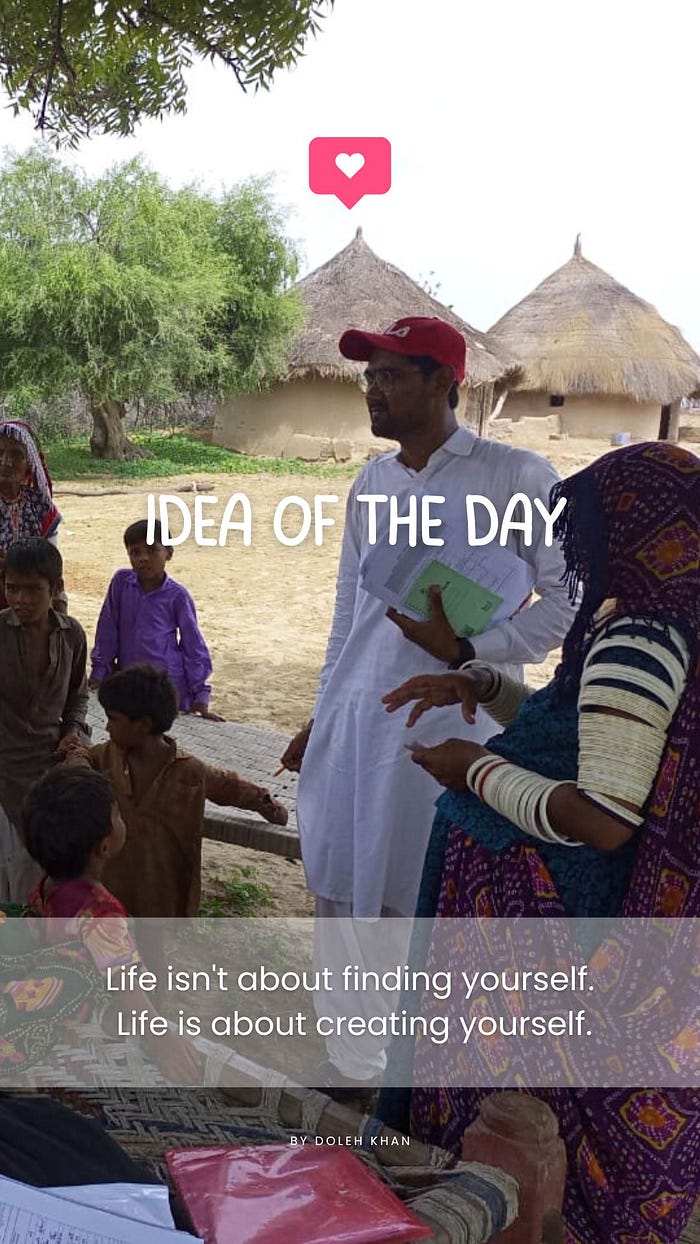The Untold Story of Women’s Sindhi Ralli in Sindh Pakistan
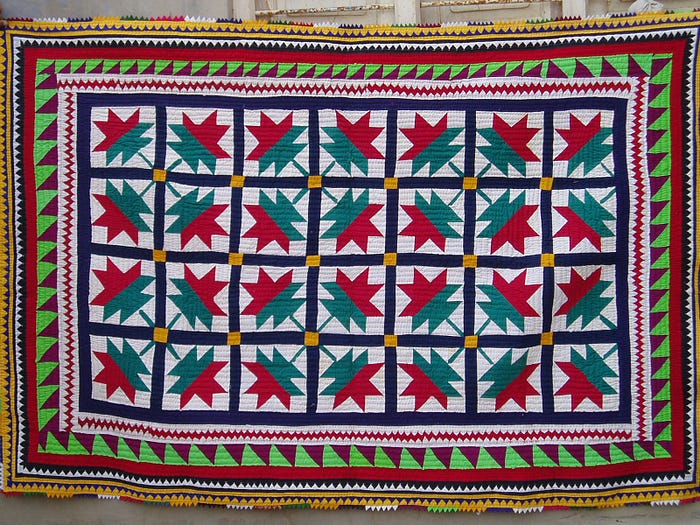
Sindh, a land of enchanting beauty, is renowned for its warm hospitality. The locals take immense pride in presenting their guests with gifts of Ajrak, Topi, and loiee as a symbol of honor. But amidst this gracious hospitality lies a secret story of women who have contributed significantly to the art and design industry of Sindh. This traditional art is known as Ralli, a patchwork quilt, that is made by the women of the Sindh region of Pakistan.
The art of making Ralli dates back to ancient times and has been passed down from one generation of women to the next. This timeless artwork is not only appreciated by the people of Sindh but also by those from different cultures and traditions. The process of creating elegant designs is simple, as all that is required are pieces of cloth, which are then transformed into beautiful quilts. Women have been creating these quilts for thousands of years, and today, Ralli is gaining international recognition. In Sindh, it has become a cultural heritage that is proudly displayed in every household. Ralli is not only used as a quilt but can also be used as a wall hanging to adorn the walls of homes. The beauty of Sindh is not only in its hospitality but also in the exquisite artwork created by its women. The legacy of Ralli continues to thrive, and its intricate designs are a testament to the skill and creativity of the women who have kept this tradition alive for centuries.
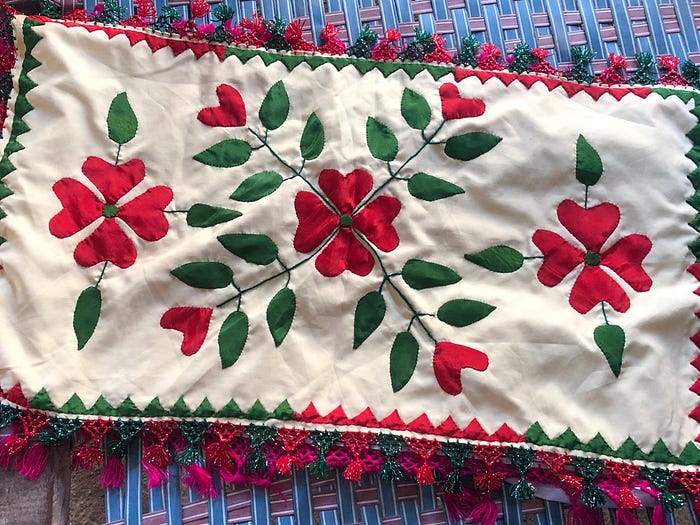



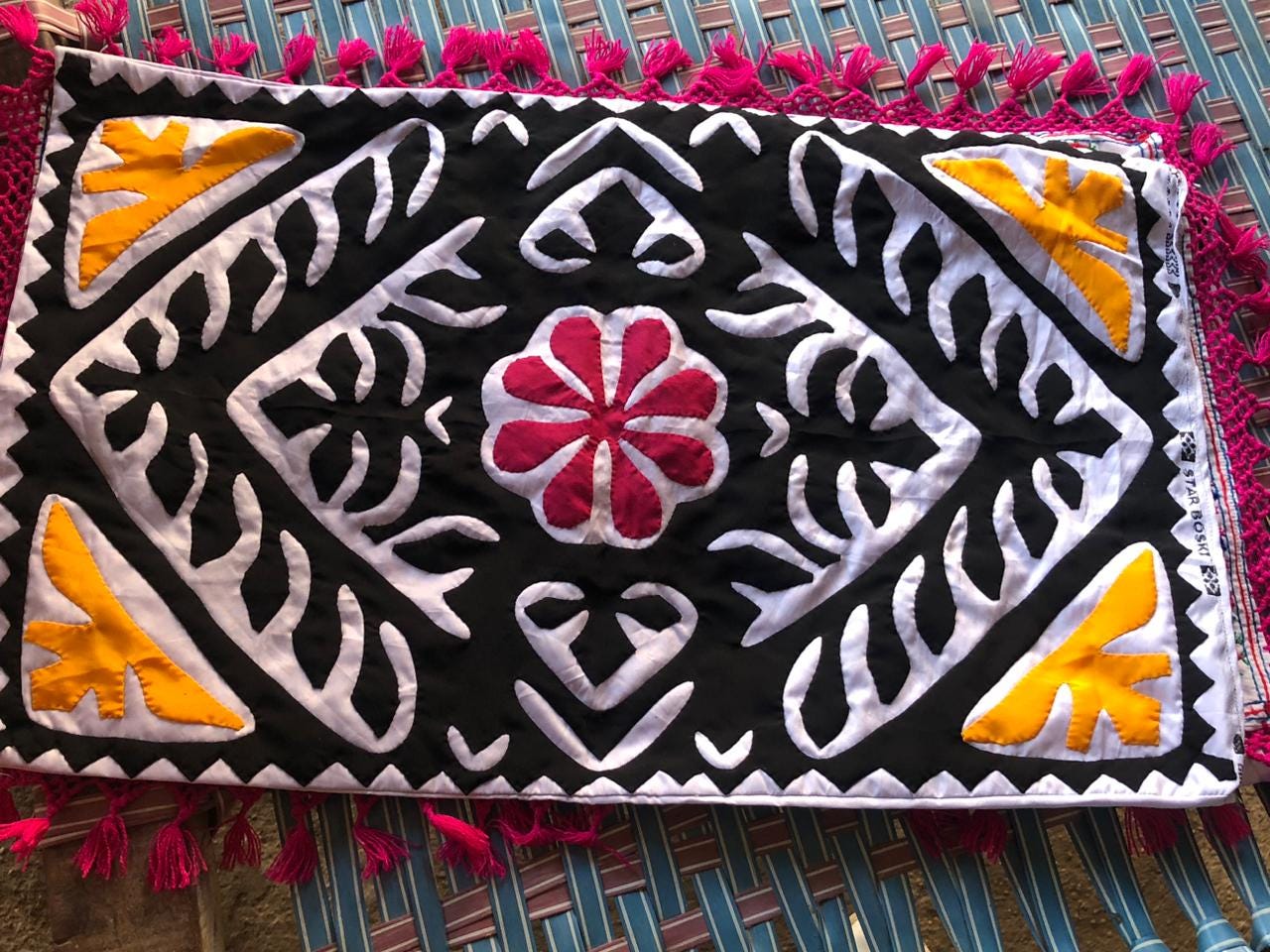

I believe these images align beautifully with the contest’s theme, illustrating how cultural traditions can foster environments of safety and empowerment for women. I would be honored to share this perspective through my lens and contribute to the dialogue around safe spaces for women.
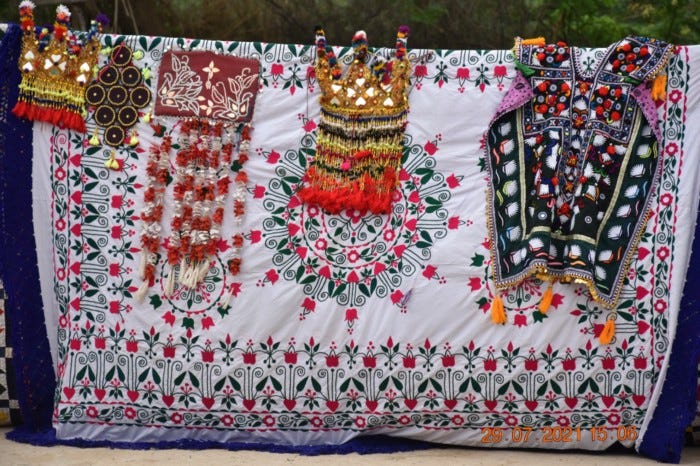
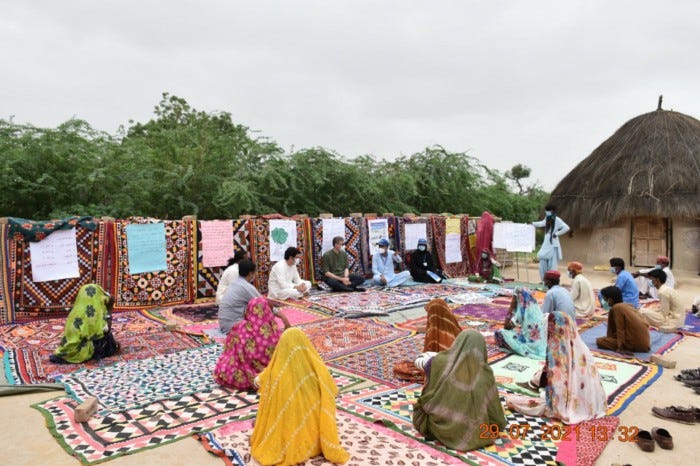
HISTORY OF WOMEN’S RALLI
The craft of ralli-making has been practiced for centuries by women in the regions of Sindh and Gujarat in Pakistan and India. The word “Ralli” comes from the local word “Ralanna,” which means to connect or mix. The traditional ralli usually consists of seven basic colors, including yellow, black, red, green, purple, blue, and white. While ralli can also be made with just two colors, the beauty of the seven colors is unique.
Apart from being an economic activity, the Sindhi Ralli is a symbol of resistance against gender-based violence and discrimination faced by women in Sindh. Domestic violence, forced marriages, and honor killings are some of the challenges that women in Sindh encounter. The making of the Ralli brings women together, providing a space for them to share their experiences and support each other. The sense of community created by ralli-making empowers women, enabling them to become financially independent and start their own businesses, breaking free from patriarchal social norms.
Despite being the primary makers of ralli for centuries, women have often been excluded from the decision-making processes surrounding the craft. In many cases, men have been the gatekeepers of resources, knowledge, and power in the ralli-making industry. This exclusion has limited women’s access to credit, market opportunities, and training, and they have been underpaid for their work.
The ralli is made by stitching together small pieces of fabric, often recycled from old clothing or other textiles. The patterns and colors used in the ralli often have symbolic meanings and reflect the natural environment and cultural traditions of the region. Women come together to create these beautiful quilts, sharing stories and exchanging ideas as they work. Ralli-making has traditionally been a women’s craft, and it has been a means of economic empowerment for women in rural areas. They often gather together to make ralli, share techniques and patterns, and sell their creations in local markets or to tourists.
In recent years, the Sindhi Ralli has gained recognition outside of Pakistan, with exhibitions and showcases around the world. This has helped raise awareness of the importance of traditional crafts in empowering women and preserving cultural heritage. Despite this, the art of ralli-making has been under threat due to the rise of cheap, mass-produced textiles, leading to a decline in demand for handmade ralli. To preserve this important aspect of Sindhi culture, organizations have been established to support ralli-makers, provide training and resources, and promote it as a form of artistic expression and cultural heritage.
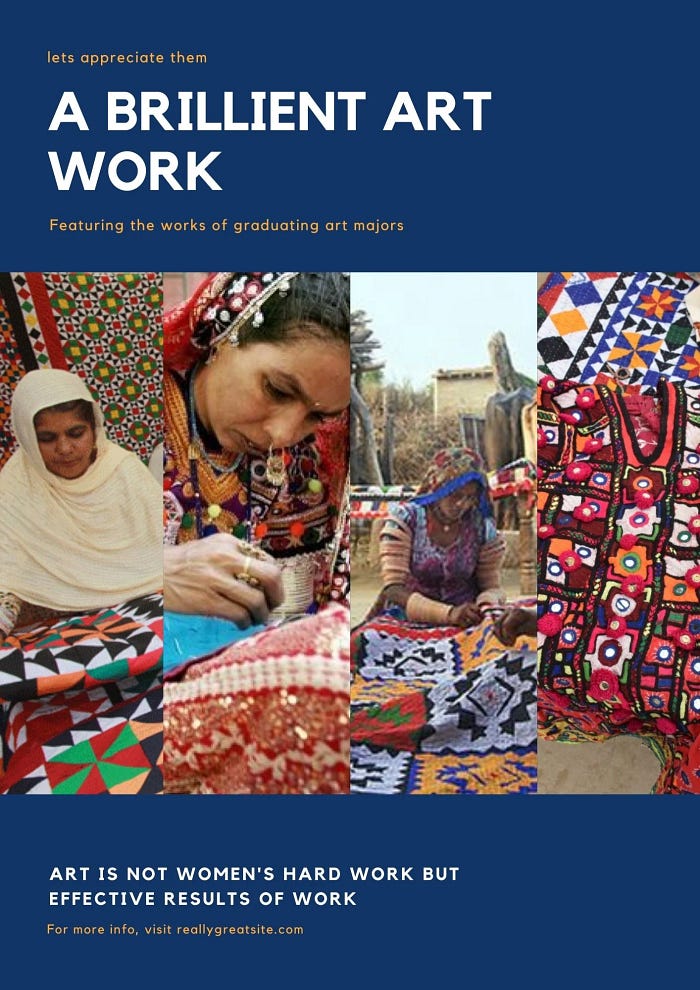
THARPAKAR:
During my visit to Tharparkar, I had the opportunity to meet some expert women and gather information about Rallis. These women shared their different perspectives and priorities when it comes to making Rallis. One such woman, Rukhsana Jalil, is a famous artist in the village of Salah Shah. Despite raising eight children, she has been sewing and selling these Ralli from home for years. According to Rukhsana, it can take up to a week to complete a single bed sheet and over a month for a double bed sheet. She has passed on her knowledge of the skill to two of her daughters. Another woman, Samina Bibi, has ten artisans working under her in Tharparkar. They prepare ralli bed sheets, cushion covers, and shirts. Samina’s artisans create beautiful designs ranging from floral to bird motifs, such as peacocks.
Tharparkar is known for its remarkable ralli artwork, which is done by the women of the region. These beautiful art pieces consist of intricate patterns and creative designs that reflect the culture of Sindh. Ralli-making is a cottage industry in Pakistan and a proper source of earning for the women of Sindh. These colorful quilts are a delight to the eyes and are a reflection of the hard work and creativity of the women who make them.
In Tharparkar, a district in the southeastern region of Pakistan’s Sindh province, women are involved in various fields of work, including farming, brick making, land work, housework, grass cutting, and woodcutting. However, a unique aspect of their work is their skill in creating Rallis, beautiful patchwork quilts made using traditional geometric designs and techniques such as removing lint from the yarn and using beads to cover the patchwork.
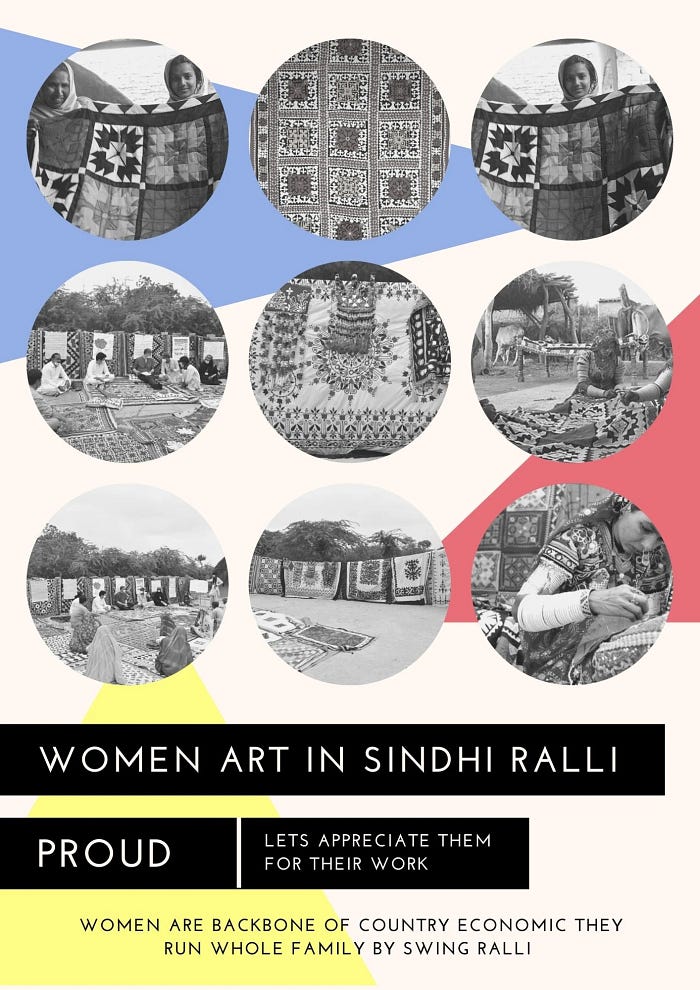
Women in Tharparkar work together to create these beautiful Rallis day and night, using their own hands and skills to produce intricate designs. Many women who are gifted in this art have discovered the potential of their talent and the earning potential it presents. As a result, they have focused on creating Rallis and other handicrafts, contributing to the development of their society. Some Rallis produced by these women are highly valued, with prices reaching up to Rs. 3,000,000 due to the intricate embroidery and glasswork incorporated into the designs. These high prices not only reflect the quality of their work but also the recognition of their skill and contribution to the culture and economy of the region. (source, Dawn.com)
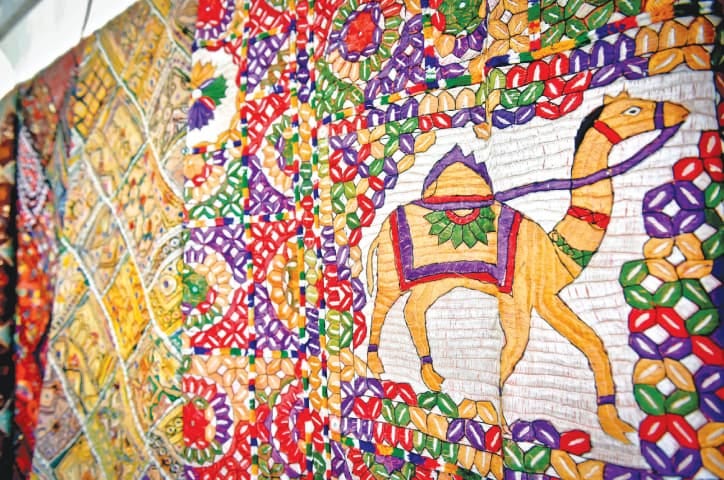

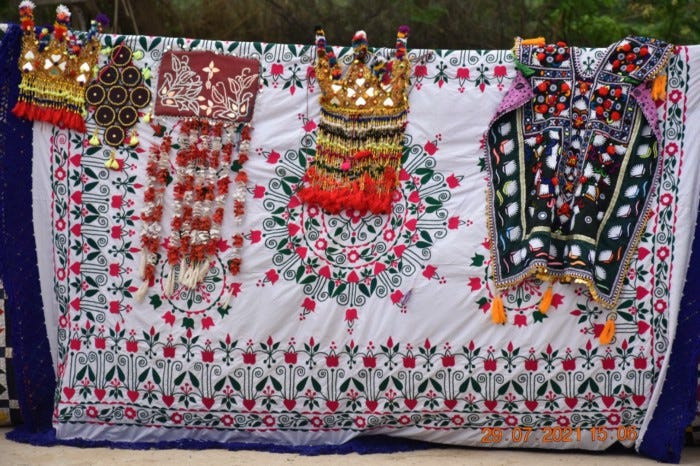

CHALLENGES:
Despite the cultural and economic significance of Ralli, makers of this traditional art form face several challenges that threaten its sustainability. One of the main challenges is competition from mass-produced goods. As more and more people turn to cheaper, factory-produced textiles, the demand for handcrafted Ralli is decreasing, and makers are finding it harder to sell their products.
Another challenge faced by Ralli makers is the difficulty of finding markets for their products. While Ralli is highly valued within the region where it originated, it is not well-known outside of this area. As a result, Ralli makers struggle to find customers who are willing to pay fair prices for their work. Additionally, Ralli makers face several practical challenges related to the production process. For example, the lack of access to high-quality materials can make it difficult to create intricate designs. Makers also have to contend with limited resources and poor working conditions, which can make it challenging to produce high-quality products consistently.
Despite these challenges, Ralli makers continue to persevere, finding new ways to adapt to changing market conditions and preserve their craft. Some makers have turned to social media and e-commerce platforms to reach a wider audience and promote their products. Others have sought out new materials and techniques to create more unique and innovative designs. However, despite their contributions, women’s work in ralli-making has been undervalued. Middlemen take a large share of the profits, and many women who make ralli do not receive fair compensation for their work. Women’s skills and creativity are often not recognized, and they are not given the same opportunities for artistic development as men. But women have worked to reclaim their place in the tradition and assert their rights as skilled ralli makers. They have formed cooperatives and collectives to market their ralli directly to buyers, cutting out the middlemen who have historically exploited them. Women have also organized to demand better access to resources and training opportunities and to advocate for their rights as artisans. In order to ensure the sustainability of Ralli and other traditional crafts, it is essential that makers receive the support they need to overcome these challenges.
FUTURE:
Despite the challenges faced by Ralli makers, there are reasons to be hopeful about the future of this traditional art form. As more people become interested in sustainable, handcrafted goods, there is potential for Ralli to gain more recognition and value in the market. Additionally, initiatives to support Ralli makers and promote the cultural significance of this art form can help to ensure its sustainability and continuation for generations to come.
By asserting their rights as skilled artisans and innovators, women are reshaping the discourse around ralli making and challenging the patriarchal structures that have historically excluded them. The story of the Sindhi Ralli is a powerful reminder that feminist empowerment comes in many forms, and that traditional crafts and practices can be a source of both cultural pride and social change. Through the making of the Ralli, women in Sindh have found a way to assert their identity, support each other, and create economic opportunities for themselves and their families. It is a story that deserves to be told and celebrated for years to come.
CONCLUSION:
Ralli is a unique and beautiful traditional art form that holds cultural and economic significance for the people of Tharparkar and the wider region. However, Ralli makers face several challenges, such as competition from mass-produced goods and limited access to resources and markets. Despite these challenges, there is hope for the future of Ralli, as makers continue to innovate and adapt to changing market conditions. By supporting Ralli makers and promoting the value of this art form, we can help to ensure its sustainability and preservation for future generations. n conclusion, Ralli is an important part of the cultural heritage of Sindh and a source of pride for the people of Tharparkar. It represents the creativity, skill, and ingenuity of the women who create it, and its preservation is crucial for the cultural and economic well-being of the region. By recognizing and valuing the importance of Ralli, we can help to support the makers and ensure the continuation of this beautiful art form for years to come.
